| . . . low-level aerobatics that he had not trained for. That taught us respect for flying but did not dampen our spirits.
| After going solo on the Harvard we all considered ourselves SHPs ( S--- Hot Pilots). Later in the summer four or five of us were scheduled for navigation flights on the same day and we made arrangements to meet at point Charlie. I was first out and after the others arrived at Charlie we had a mock dogfight. It was a good melee. Unfortunately we had been seen by an instructor below us and my instructor was waiting on my arrival back at base. I did not have time to fudge the times in my nav log and was caught red-handed, as were the others. Our punishment was to march around the base with our back-pack parachutes on. This meant walking hunched over and with the leg straps chafing the thighs. Suitable I suppose. |
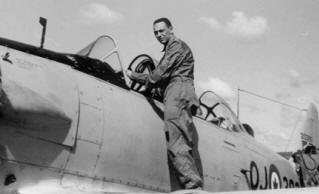
Self on Harvard wing at Claresholm, 1953. We were all SHPs after going solo in the Harvard. |
| 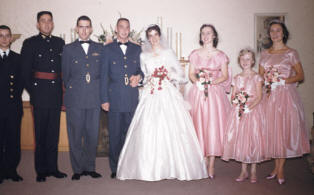
The Fraser wedding with three other Class of ‘56ers standing by – 3551 Hall Graham, RCAF, 3646 Fred Simpkin, RCE, and 3576 Tom Croil, RCN. |
To finish Harvard training at Penhold in ’54 four of us did our formation tests on Labour Day weekend. There were no other aircraft on the ramp so we ended by fast taxiing down the ramp with our tails in the air. We really were SHPs. We received our coveted Wings after T-33 training at MacDonald in 1957. By then we had our degrees, were older and were ready for the serious business of flying.
Also, Lee and I had been married in
September, 1956. My first posting was on CF-100s with 409 Squadron at Comox, BC. I was crewed with an excellent Air Intercept Navigator (AI Nav / back-seater) named Tom Platt and we flew just under 1,000 hours together all across Canada between 1958 and 1961. |
During All Weather training at Cold Lake we had a close call with another training aircraft. While in a steep turn away from the target we passed just above another crew doing the same turn from the other side. Neither could see the other as we were above each other in the horizontal. The other pilot was a future Chief of Defence Staff, 3528 General Paul.D. Manson, Class of ‘56. After that all crews were told to remain on one side of the target.
| Later Tom and I were one of two crews to represent our Squadron at the 1961 Air Defence Command Rocket Meet at Cold Lake.
In ’58 the CF was still a world class aircraft. The US Air Force was still using the F-89 Scorpion and those two aircraft were NORAD’s first line of defence. The F-89 had to keep one engine continuously in after burner to keep up with us above 40.000 feet.
One day Tom and I had gone out over the Pacific ocean and then turned east to simulate a hostile target heading for the Canada /US west coast. We had climbed the whole flight and were at 51,800 feet, as high as that particular aircraft would go that day. As we approached the coast one of the USAF’s new F-102 Century Series fighters made a pass at us and did a very nice, very large barrel roll at our altitude. In that instant the CF-100 was obsolete. I retarded the throttles and never went above 51,000 again. |
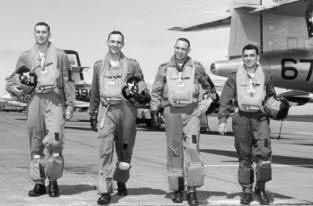
409 Squadron aircrew at the 1961 Air Defence Command Rocket Meet at Cold Lake. Left to right: F/Os 3606 Bob Burnie, Class of ‘56, Nav, his pilot, Dick Bentham, Self and Tom Platt, Nav. |
Instructing advanced flying at Portage La Prairie proved that the teacher does learn from the student. Every mistake a student made reinforced, for the instructor, the correct way to do something. The NATO Norwegian cadets were screened prior to coming to Canada and were excellent students. Tell them / show them once and they had it right. The same was true of the better Canadian students but there were some who were just not natural pilots. One of mine had great trouble with instrument flying. He could brief me on exactly what he was supposed to do, could do each part separately but could not put the whole together. He scraped through the course and was posted to light transport where he would be flying with another pilot.
| 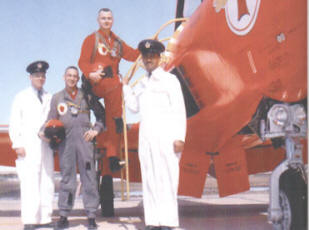
Official photo of self as back up Red Knight,
1962, with red T-33.
|
Portage, of course, was home base for the Red Knight and I was involved as the back-up for Dave Barker in 1962 and as Red Knight in 1963. For a commentary I refer you to pages 207 and 208 of 10223 Lt Col Dan Dempsey’s excellent book, A Tradition Of Excellence, Canada’s Airshow Team Heritage. I would add only that training for and executing low level aerobatics was both a self discipline experience and the opportunity to wring out that urge to go low and fast that every pilot has. Read more about the Red Knight and
"A Tradition of Excellance" |
| 2140 Air Commodore DAR Bradshaw had been the Commandant at RMC when the Class of ’56 graduated. In 1963 he was promoted Air Vice Marshal (AVM) and made Air Officer Commanding (AOC) of Canada’s N0. 1 Air Division Headquartered in Metz, France. I was posted out in the middle of my Red Knight tour to be his Executive Assistant (EA) and the job included T-33 flying around Europe. Air traffic control over France was a bit lax at that time and one day The Boss and I were south bound to Sardinia. He was in the front flying with me in the back working the radios when he called a visual contact. I relayed the info to France control who replied that there was no traffic in our area. |
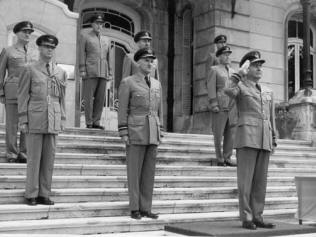
Self as Executive Assistant, with AVM Bradshaw and other staff officers on the steps of the Chateau de Mercy, Metz, France, 16 June, 1964, as the Chief of the Air Staff, RCAF, takes the parade salute. |
The AVM then radioed that this was General de Division Bradshaw and that there was traffic. We heard nothing more from France and finally called Italian control approaching Cagliari, Sardinia.
| 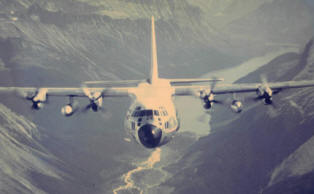
A C-130 Hercules working somewhere. I flew Hercs from 1966 through 1974. |
At the end of this tour in 1966 I was posted to the F-104 Recce role but just days before leaving Europe I received a phone call asking if I would take a position flying C-130 Hercules with 435 Squadron in Edmonton. I said yes and just like that became a transport driver. The Herc is a real gentleman’s aircraft. You can lie down and take a nap, get up and walk around, go to the bathroom, cook a steak, and freight does not talk back. It also has a crew so there are always back-up opinions, four engines and 14 hours fuel, and will go anywhere. |
I was into 3,000 foot gravel strips in the Canadian arctic delivering supplies and on one of the longest runways in the world at Kinshasa in the Congo with Canadian beer for the embassy staff there. One winter I was Aircraft Commander on the Herc part of a mission that took then Governor General Michener and Mrs. Michener on a tour of the Canadian arctic. I was cutting a corner near Greenland to give them a better view of the Humboldt glacier when Mrs. Michener noted that we were out of Canadian airspace and that they were not to leave Canadian airspace without the Queen’s permission. We quickly returned to Canada. On this trip we landed them on the sea ice at Rankin Inlet. We had to have 55 inches of ice to support the Herc.
Transport supply flights went around the world, literally, by heading west out of Trenton, Ontario, and continuing west until back at Trenton. On one such flight we had to avoid artillery fire while going into and out of Saigon at the height of the US Vietnam conflict. Close enough to being shot at for a Canadian transport aircraft. On another flight out to India and back a gyro instrument failed while we were over Greece. As the weather was clear we continued to our next scheduled stop in Lebanon meanwhile calling Trenton to send us a replacement gyro to Lebanon. (Transport aircraft had very long range High Frequency radios and we checked in with Trenton every hour from all over the world. Handy when you needed a part.) After landing we spent the next five sunny days in a very luxurious hotel in Beirut trying to get that package through Lebanese customs. On these flights I was on all the continents except Australia and Antarctica.
While at Edmonton I was promoted Squadron Leader in 1967, took the Instrument Check Pilot (ICP) course and became the Squadron Standards Officer. This lead to being posted to Transport Command HQ at Trenton, Ontario, in 1970, first as Hercules Training and Standards Officer and later as Command Instrument Check Pilot (CICP). One night I did an instrument check ride to the Kingston airport. It was nice to see the lights at RMC.
| After Staff College in 1973/74 I went to the US for two years in an exchange position at HQ, Military Airlift Command (MAC), the USAF equivalent to our Transport Command. This was not a flying position but as it was in Operations everyone there had to stay current. We flew the T-39 Sabreliner, a small executive jet, and ferried personnel around the US. |
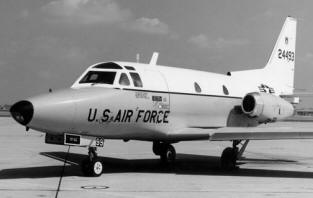
T-39 Sabreliner of USAF Military Airlift Command (MAC). I flew these to stay current while at MAC HQ, 1974 to ’76. |
MAC policy was that no one would ever hijack a MAC aircraft so all crews were armed. The co-pilot carried the gun. The greatest incentive to upgrade to captain was not to have to carry the gun. You had to have a T-39 instructor rating to carry four star or equivalent rank and as an experienced transport pilot I was soon rated and had lots of brass on board, including Secretary of Defence McNamara. On one flight with an Army 2 star and his staff the aircraft pressurization leaked rapidly during descent and the oxygen masks dropped as advertised. Adding power recovered the pressurization but there was a great scramble and a forest of hanging masks in the back until we got on the PA to tell them everything was OK. Another time we could not take off with an Army 3 star because tornados were forecast at destination. He muttered that an Army pilot could probably get him there. Army Generals were not impressed by Air Force pilots.
| Returning to Winnipeg, I was Chief of the Instrument Check Pilot (ICP) School, a division of 429 Squadron. We flew T-33s and later Tutors, and the old DC-3, Dakotas. We often had Transport Canada inspectors on the ground school portion of the course so the ICP staff decided we would all get civilian licenses. We wrote the exams and the next TC inspector on course gave us check rides on the Dak. We now all had Airline Transport Ratings (ATRs). On the ICP course the staff acted as candidates and the ICP course members flew us on simulated instrument rating check rides for their training. Three years of this well and truly honed your instrument flying.
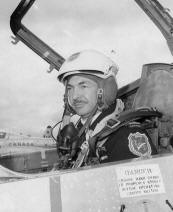
Official photo of Major Fraser, Chief, Instrument Check Pilot School, in a Tutor after the school transitioned from T-33s to Tutors, 1977. |
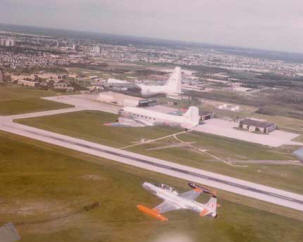
| An Instrument Check Pilot (ICP) School DC-3 Dakota and T-33 Silver Star with a Herc; the Winnipeg Air Force flight line is under the Herc. I am flying the T Bird. |
|
 Back to Issue #5 Back to Issue #5 |









